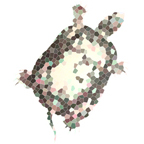 Bird Watching, by Paula McCartney, Princeton Architectural Press (www.papress.com), 2010, 120 pages, $50.00
Bird Watching, by Paula McCartney, Princeton Architectural Press (www.papress.com), 2010, 120 pages, $50.00
As publishers and birders strive for the perfect birding book – be it The Crossley ID Guide‘s photodigital-realism or The Sibley Guides‘ careful scientific illustrations – the field guide Cold War currently under way has increasingly become an arms race toward capturing an image of that perfect bird unmistakably representative of its species. Now, photographer Paula McCartney’s most recent through-the-looking-glass vision turns that concept inside out.
Not quite a coffee-table book, and in no ways a field guide, Bird Watching is instead the journal of a tongue-in-cheek experiment that explores people’s perception of nature. And if there is an object lesson to be learned from McCartney’s Bird Watching, it is that books can be deceiving.
[Experience Paula McCartney’s Bird Watching photography at the Klompching Gallery]
Fifteen years ago, McCartney tapped the zoo exhibits of days gone by as a springboard for her “Bronx Zoo” [1997-1998] project, exploring the presentation of live animals displayed against painted backdrops. Now, it is instead the animals that are faked in these dioramic wilds, with McCartney affixing Styrofoam faux-fowl to outstretched limbs with wire mounts like a flock of cheap clip-on ties. Even in their fraud, these complicit chickadees and cactus wrens complete the vistas – purposefully posed, they alight on the perfect branch, they gambol and warble and preen for the camera, they do everything short of… well, flying.
[Preview Paula McCartney’s Bird Watching book]
While McCartney offers she “wanted to make the landscape more romantic, more idyllic,” one could just as well argue that these Styrofoam simulcra are really just the subjects of a philosopher’s field guide that provides a prophetic view of a future where our only encounters with wildlife are those painted, posed with wire, and planted in the landscape – stuffed turkeys in every sense of the word. Writing in the forward, curator Karen Irvine suggests that McCartney’s fictions question our relationship to nature and wildlife, asking “What are our expectations when we approach the natural landscape?” But Irvine overlooks what McCartney’s fiction also reveals about that relationship – that in the present day where extinction is a very real consequence, McCartney’s fictions may all too closely mirror reality. With the Wild Kingdom and Planet Earth experiences of instant gratification we’ve come to expect every time we set foot outdoors becoming increasingly untenable (were they ever?), pseudo-safaris such as imagined by McCartney could become more true than – though equally as strange as – the fiction they represent.
What does this mean for you, the reader? Bird Watching is life imitating art imitating life ad infinitum. Judging from the reactions of co-workers as they thumbed through the book, you’ll either appreciate the trickery with a wry grin or be offended at the perceived treacherous transgression against the natural world.

